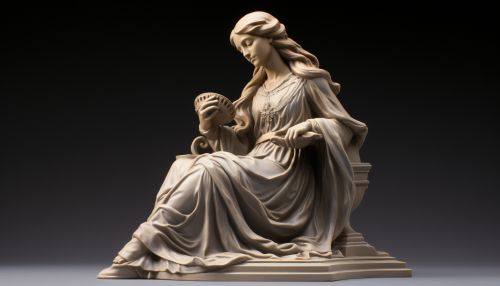Hebe
Overview
Hebe is a figure in Greek mythology, known as the goddess of youth and the cupbearer to the gods and goddesses of Mount Olympus. She is the daughter of Zeus, the king of the gods, and his wife Hera, the queen of the gods. Hebe is often depicted in ancient art as a beautiful young woman, serving nectar and ambrosia to the deities of Olympus.


Etymology and Other Names
The name 'Hebe' comes from the Greek word 'ηβη' (hēbē), which translates to 'youth' or 'the prime of life'. She was also known by the names Ganymeda and Dia, both of which refer to her role as the cupbearer of the gods. In Roman mythology, Hebe is known as Juventas, the goddess of youth and rejuvenation.
Family
Hebe is part of the Olympian Gods, a group of twelve deities who resided on Mount Olympus. Her father, Zeus, is the king of these gods, and her mother, Hera, is the queen. Hebe has numerous siblings, including Ares, the god of war, and Eileithyia, the goddess of childbirth.
Role and Responsibilities
Hebe's primary role in Greek mythology was as the cupbearer to the gods and goddesses of Mount Olympus. She served them nectar and ambrosia, the food and drink of the gods, which bestowed immortality upon those who consumed it. This role emphasized her association with youth and vitality, as the nectar and ambrosia kept the gods eternally young.
In addition to her duties as cupbearer, Hebe was also considered the goddess of youth, granting vitality and rejuvenation to mortals and immortals alike. She had the power to restore youth and vigor, which made her a figure of considerable importance in the Greek pantheon.
Depiction in Art
In ancient Greek art, Hebe is typically depicted as a beautiful young woman, often shown serving nectar and ambrosia to the other gods. She is usually portrayed in a long, flowing robe, with a cup in one hand and a jug in the other.
Worship and Cult
Hebe was worshipped in several ancient Greek cities, including Athens and Sparta. She had a temple in Phlius near Sicyon, where she was worshipped as Dia. In Rome, as Juventas, she had a temple in the Capitol and an altar in the Circus Maximus.
Marriage and Offspring
Hebe was married to the hero Heracles after his apotheosis, his transformation into a god. Together, they had two children: Alexiares and Anicetus. Both of their sons were minor deities associated with combat and defense.
